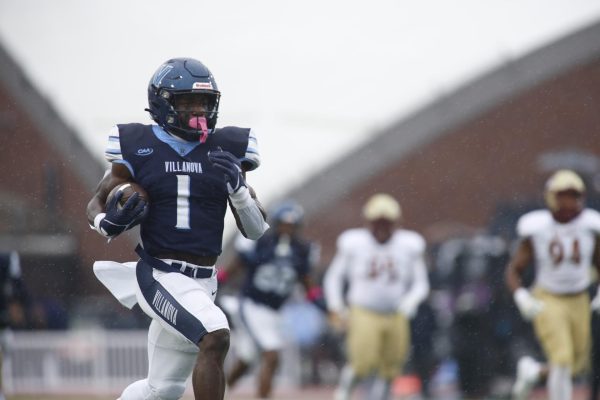Spotlight on the Service Learning Community
September 3, 2008
The corridors of Alumni Hall may not truly be haunted with ghosts, as the legends say. Rather, the building houses a different sort of monument to the soul of Villanova – the Service Learning Community. While often unnoticed by the greater Villanova population, sophomores within SLC actually live the University’s mission every day with great passion.
The passion for service that led to the SLC came from one of the community’s coordinators, Dean of the College of Liberal Arts and Sciences Noreen Cameron.
“Confucius said study without reflection is a waste of time, and reflection without study is dangerous,” Cameron says, referring to the core of the SLC. Integration of these two activities is the SLC’s purpose and place.
“If we are people who want to be involved in social justice and the improvement of human condition for people, we need to know what the problems are,” she says. “And we need to reflect on those problems in terms of our own life, our own experience and our own vocation.”
The SLC comprises 112 genuinely interested sophomores – from a pool often as large as 250 applicants – who are selected each year into the program (as well as a few junior facilitators and senior chairs). They enroll in service learning courses, with different offerings in various departments each semester.
In addition to the coursework, the students are required to complete service at a site in the Philadelphia area three hours a week – such as aiding in classrooms at Cooke Elementary School or tutoring at the Urban Bridges Adult Literacy Program. They also participate in a mandatory reflection seminar called “Fourth Hour” and take part in other days of service and projects throughout the year. And if that weren’t enough, they all live together, too – a pertinent part of the SLC journey.
Throughout the year, all members not only serve in and learn about the areas of social inequity but also reflect on their actions and learning within a bigger picture.
“We have to figure out why we’re serving,” Cameron says. “Why would I do this as a person, as a human being? And why am I invested in the life of another human being?”
Standing out among these educational and service processes is the community action project each service site group must complete in the spring semester. Past projects include the development of a college resource room for West Philadelphia’s School of the Future (a Microsoft initiative that incorporates technology in all areas of the school). The project involved a large amount of research on college admissions information for the students, as well as raising $4,000 for items and tools for the room. Amanda McCarthy, one of the current senior co-chairs, recalls her group’s project from sophomore year – developing a peer mediation program at Cooke Elementary School.
“We came up with a peer mediation curriculum, we had teachers recommend students, we chose peer mediators, they came to Villanova and we had a day for them,” she says. “It was a semester-long project that would carry on after we were done.”
The Fourth Hour seminar also greatly defines the program. Incorporating readings and discussion with junior facilitators and staff advisers from various departments within the University, this reflection portion of the program is unique from any other at Villanova.
“What they are designed to do is give people who are serving a chance to reflect on the service they are doing and the things that they’re learning about in their service learning classes on a personal basis and to try and figure out what their responses should be and how they can help their communities more,” says Chris Schettini, SLC senior co-chair. “It’s just another way of learning, really.”
Topics discussed include issues of race and poverty, as well as inequities in areas such as education, as the SLC does a lot of service within schools in the area.
“Philadelphia has many inequalities,” Schettini says. “There are great riches in Philadelphia, and there’s great poverty. But I think it’s easy to turn Philadelphia into a cartoon and oversimplify things.”
Mike Decina, a current SLC junior facilitator, holds a new outlook from his experience in the program.
“The aspect of SLC that I did not see coming was my own personal shock to conditions that many people live in only 20 minutes away from Villanova,” he says. “Going to service once a week opened my eyes to a whole new world, something that I did not know existed.”
McCarthy feels the program gets a good response from the people the students serve every week, particularly from enthusiastic service sites. Even something as small as painting games on blacktop for recess is often received with gratitude and engagement from the people living within the site.
“We keep emphasizing the idea that we’re trying to meet needs that are there,” McCarthy says. “With the discussions, with the community action projects, we’re not trying to tell people what they need; we’re trying to ask them what they need, and serve accordingly.”
Cameron recalls a day of service when Villanovans helped elementary school students in Philadelphia clean up a park. After it was over, the entire group had a discussion in which they talked about what they wanted to “grow up” to be.
“I had one young man [from Villanova] look up and say, ‘I want to be president of the United States. No, I’m not crazy; that’s really my aspiration,'” she says. “And he looked at the children, and he said ‘And I’ll tell you, I will never forget this moment if I am president.'”
“That’s what we expect,” Cameron says. “That whatever you do in life, that you will not forget those moments, and you will know how to educate yourself about the issues that are concerned with those moments.”










